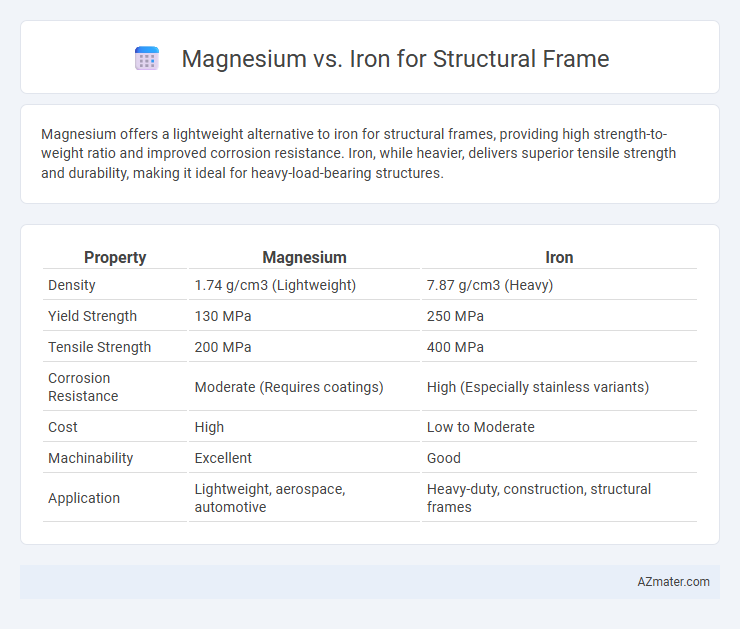Magnesium offers a lightweight alternative to iron for structural frames, providing high strength-to-weight ratio and improved corrosion resistance. Iron, while heavier, delivers superior tensile strength and durability, making it ideal for heavy-load-bearing structures.
Table of Comparison
| Property | Magnesium | Iron |
|---|---|---|
| Density | 1.74 g/cm3 (Lightweight) | 7.87 g/cm3 (Heavy) |
| Yield Strength | 130 MPa | 250 MPa |
| Tensile Strength | 200 MPa | 400 MPa |
| Corrosion Resistance | Moderate (Requires coatings) | High (Especially stainless variants) |
| Cost | High | Low to Moderate |
| Machinability | Excellent | Good |
| Application | Lightweight, aerospace, automotive | Heavy-duty, construction, structural frames |
Introduction to Structural Frame Materials
Magnesium and iron are fundamental metals used in structural frame materials, with iron widely favored for its high tensile strength and durability in construction frameworks. Magnesium offers a lightweight alternative, reducing overall structure weight and enhancing energy efficiency, especially in automotive and aerospace applications. Selecting between magnesium and iron depends on balancing strength requirements, weight constraints, and environmental conditions for optimal structural frame performance.
Key Properties of Magnesium and Iron
Magnesium offers a high strength-to-weight ratio, making it ideal for lightweight structural frames, with a density of about 1.74 g/cm3 compared to iron's 7.87 g/cm3, significantly reducing overall weight. Iron provides superior tensile strength and durability, with its compressive strength often exceeding 250 MPa, suitable for heavy-load-bearing applications. Both metals exhibit excellent corrosion resistance when treated properly, but magnesium requires protective coatings due to its higher susceptibility to oxidation.
Weight Comparison: Magnesium vs Iron
Magnesium weighs approximately 1.74 grams per cubic centimeter, making it one of the lightest structural metals, while iron has a density of about 7.87 grams per cubic centimeter. This significant difference means magnesium is roughly 78% lighter than iron, offering substantial weight savings in structural frame applications. The reduced weight of magnesium frames enhances overall efficiency, especially in automotive and aerospace industries where minimizing mass is critical for performance and fuel economy.
Strength and Durability Considerations
Magnesium alloys offer a high strength-to-weight ratio, making them ideal for lightweight structural frames where reducing overall mass is crucial. Iron, particularly in the form of steel, provides superior durability and resistance to wear and impact, ensuring long-term structural integrity in heavy-load applications. While magnesium excels in weight-sensitive designs, iron's robustness makes it more suitable for frameworks requiring maximum strength and longevity under harsh conditions.
Corrosion Resistance: Which Performs Better?
Magnesium alloys exhibit lower corrosion resistance compared to iron-based materials due to their higher electrochemical activity, making them more susceptible to oxidation and degradation in humid or saline environments. Iron, particularly when treated with protective coatings or alloyed in forms such as stainless steel, offers superior corrosion resistance and durability for structural frames. Therefore, iron-based materials generally outperform magnesium in resisting corrosion, extending the lifespan of structural components in adverse conditions.
Cost Analysis of Magnesium and Iron
Magnesium offers a lower density and improved strength-to-weight ratio compared to iron, reducing material costs in applications needing lightweight structural frames despite its higher raw material price. Iron benefits from widespread availability and established manufacturing processes, leading to overall lower production costs and easier recyclability in large-scale construction projects. Cost analysis must balance initial material expenses of magnesium against iron's heavier weight implications on transportation and assembly costs.
Fabrication and Machining Differences
Magnesium alloys offer superior machinability with lower cutting forces and faster processing speeds compared to iron, reducing fabrication time and tool wear in structural frame production. Iron's higher density and hardness result in increased machining difficulty, typically requiring more robust equipment and slower machining rates to avoid tool damage. Fabrication of magnesium components benefits from its lighter weight and excellent damping properties, while iron frames provide greater strength but demand more intensive handling and finishing processes.
Environmental Impact and Sustainability
Magnesium offers a significantly lower carbon footprint than iron, with its production emitting less CO2 due to abundant natural reserves and energy-efficient extraction methods. While iron's recyclability is high, magnesium's lighter weight reduces transportation emissions and material usage in structural frames, enhancing overall sustainability. Choosing magnesium can lead to more eco-friendly construction practices by minimizing resource depletion and lowering greenhouse gas emissions in the building industry.
Applications in Modern Construction
Magnesium alloys offer lightweight strength and excellent corrosion resistance, making them ideal for aerospace and automotive structural frames with weight-sensitive designs. Iron, particularly in the form of steel, provides superior tensile strength and durability, widely used in high-load-bearing applications like skyscraper frameworks and bridges. Modern construction often combines magnesium alloys with steel to optimize both weight efficiency and structural integrity in advanced architectural projects.
Choosing the Right Material for Your Structural Frame
Magnesium offers a lightweight advantage with high strength-to-weight ratio ideal for reducing overall structure weight without compromising durability in structural frames, while iron provides superior rigidity and exceptional load-bearing capacity essential for heavy-duty applications. Evaluating environmental exposure, corrosion resistance favors magnesium alloys in non-humid environments, whereas iron requires protective coatings or stainless variants in moisture-prone conditions. Selection depends on balancing weight constraints, mechanical strength requirements, and corrosion resistance tailored to specific structural frame demands.

Infographic: Magnesium vs Iron for Structural Frame
 azmater.com
azmater.com